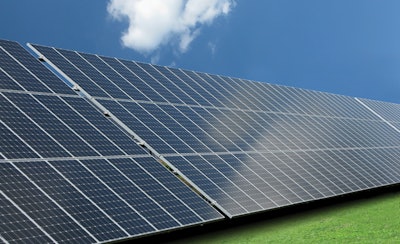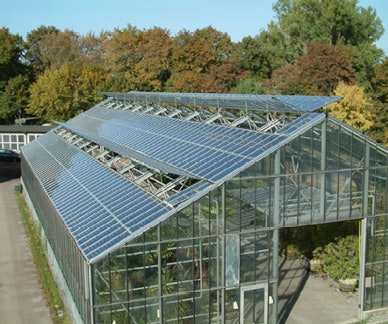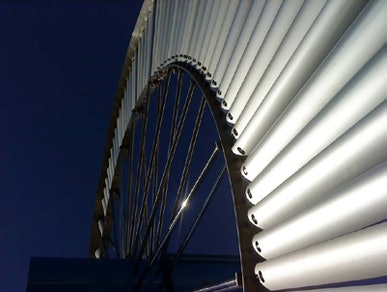
The excitement about the opportunities legal cannabis production brings to individuals and business communities masks a growing problem: The water and energy consumption used by indoor cultivation facilities is cutting into profits and jeopardizing the long-term viability of many businesses. In addition, the industry is increasingly under scrutiny for significant energy and water use. For example, the city of Denver recorded a jump in energy demand from 86 million kWh in 2012 to 148 million kWh in 2014, due to cannabis production. The amount of water required for growing facilities is said to be a contributing factor to the ongoing drought in the western United States. Smart strategies are needed now to cut cultivators’ costs and lessen environmental impacts as legal cannabis continues to expand its reach.
Here Comes the Sun: Solar Panels
One smart option cultivators can consider is solar PV (photovoltaic) panels. While it can take several years to offset installation, the long-term benefits are numerous. Today’s panels have no moving parts, silently convert natural sunlight into electricity and have minimal environmental impact. They provide power reliability, cost control and budget certainty, and are ideal for supplementing systems during peak usage times and for sites that get a lot of sun.
Historical data has shown that the life span of solar PV panels has exceeded the manufacturer’s warranty of 20 to 25 years. Two technologies are available: Single crystal and polycrystalline PV modules contain cells made from silicon wafers that produce electricity when capturing the sun’s energy. Amorphous silicon modules (thin film) do the same thing, but require 50-percent more surface area to achieve similar results. A solar consultant can advise growers on which type of panel will best suit their facilities and objectives.
Cultivators also can buy electricity through solar purchase power agreements (SPPAs) for energy generated by solar PV equipment that is owned by a solar services provider. In other words, the cultivator is essentially leasing the equipment, avoiding up-front installation costs. However, other benefits, including tax incentives and a healthy cut of the profits, go to the provider.
Cultivators who want to own their energy-generating equipment need to consider the capital expenditures (CAPEX) needed to cover all aspects of the system, including the equipment selling price; engineering and space requirements of available ground and roof module installations; the inverter; battery-bank component parts; energy storage and product warranty costs. The selling price of produced power is not a variable required for determining capital expense amounts. Any amount of excess energy produced would be an income line item on the balance sheet.
The “U.S. Solar Market Insight Report” (Q1 2015 Executive Summary) released by the Solar Energy Industries Association cites that turnkey installed solar systems for non-residential solar systems cost up to $3.50 per watt ($/Wdc = Dollars/Watts direct current) for an installation. Estimates for small-scale, commercial rooftop installations can exceed $3 per watt. In some cases, surplus kilowatts produced can be sold back to the grid through a process called net metering, which turns a previous expense liability into a new profit source.
Calculating net present value (NPV) of panel equipment, including maintenance cost, needs to include performance value and financial risks (the cost of capital investment) over the lifespan of the product.
Saving Money is a Breeze: Wind Energy
Wind energy, one of today’s lower-cost renewable energy technologies, has become commonplace worldwide. Unlike solar panels, wind generators’ capacity to produce power is not limited to the hours between sunrise and sunset. The kinetic energy of wind is measured in watts per square meter (W/m2) converted by turbines into mechanical energy through the use of airfoils that drive an alternator to produce electricity.
Small wind systems are typically used for agriculture and small commercial use for electricity generation of less than a 100 kilowatt (kW) capacity. If there are consistent wind conditions at a cultivation site, there is a good chance that enough wind may be available for a wind turbine. An average wind speed of at least 10 MPH at a hub height of 50 feet is required to provide enough usable constant power. With many variables in installation, it’s difficult to name an estimated cost or energy savings.
Leveraging Multiple Energy Options
Another renewable energy strategy is combined heat and power (CHP), which utilizes generated electricity and thermal energy for a system that protects the crop from utility blackouts. In addition to being an effective energy strategy, many growers have reported that it’s great for drying harvests (more on this below).
The triple-redundant energy system provides reliable power via two on-site generators that operate on natural gas and diesel fuel (unless state restrictions apply), and it remains connected to the traditional grid, providing the third source. CHP can be a primary source of energy or used only during peak demand hours (which are billed at the highest rates) to reduce energy costs.
Commercial real estate, data centers and worldwide indoor agriculture sites commonly use this option for power supply. This strategy reduces energy spikes, minimizes the potential for blackouts and, through recycling the energy created on site, reduces energy costs from 10 percent to 20 percent.
The engines provide usable outputs, beyond electricity, that increase efficiency, and include hot water and steam that incorporate output for heated air, chilled water (absorption chillers) and the CO2 from exhaust. Cannabis operations find these byproducts beneficial for many stages of the growing cycle. In addition, the CO2 exhaust is cleaned, cooled and re-introduced into the system as fertilizer, and can increase the crop yield by as much as 20 percent.
CHP equipment provides scalable system sizes from 150 kW to 5 MW. Maintenance is required every 4,000 hours, and a system overhaul is needed after 64,000 hours of continuous use.
If the property owner purchases only the energy produced on-site, the equipment cost and maintenance falls on the equipment owner. Cultivators can contract through a long-term energy services agreement (ESA) that provides set terms for electricity up to 15 years at competitive rates, providing budget certainty. Neither cash nor project financing is needed under this option.
The equipment performance is affected by ambient weather conditions and altitude — considerations that need to be factored in when performing a return on investment (ROI) analysis.

Geothermal Energy: Maximum Energy Efficiency
According to the EPA, geothermal energy is the most energy-efficient, environmentally clean and cost-effective space-conditioning system available. Geothermal energy is heat that is extracted from hot water or steam from geothermal underground reservoirs to generate electricity. Cost to install a geothermal heating system varies greatly by region. Average cost is approximately $2,500 per ton. The geothermal system paybacks also will vary with region, and generally runs 10-15 years, respectively.
The Database of State Incentives for Renewable Energy (DSIRE) provides information on local, state and federal-level rebates, incentives, grant programs and tax credits. Through DSIRE, cultivators can access accurate information that is well-organized and simple to navigate. Incentive dollars are refreshed each year for energy-efficiency programs and are offered on a first-come, first-served basis. The federal investment tax credit (ITC) program offers a tax credit of 30 percent for on-site energy production; importantly, the program due to expire Dec. 31, 2016, was just granted another five-year extension, which will ease the pressure. Installations will now be about 9.1 gigawatts, according to a revised forecast from Bloomberg New Energy Finance. The extended program has a reducing tax credit that will be lowered to 10 percent nearer to the program final end date. The ITC tax credit program is for real estate land and property owners. Each utility service provider in legal states should offer local and utility-based incentive programs for qualifying energy-efficient technologies and on-site generation. How each power service provider is working with the legalized cannabis market in its service territory is another question.

A Smart Energy Strategy is Needed Now
The best choice for energy efficiency and sustainability naturally comes down to money. Though the legal U.S. marijuana industry is estimated at just under $3 billion annually, it is mostly a cash business with no credit history or debt established through traditional financing.
While cultivators, the community and environment wait on U.S. banking solutions to emerge, cultivators need to pursue other financing options, including venture capital and private equity, to bring down energy usage and costs sooner rather than later.
While some growers might feel like managing energy costs can come after profits are established, it’s critical to bring down usage and costs now, as energy-cost reductions will begin to contribute to the bottom line immediately, and the industry’s practices are under intense scrutiny.
The urgency to reduce the electric power demand of indoor marijuana cultivation isn’t a regional grid issue, it’s a systemic issue. Communities are likely to implement regulatory controls to alleviate strain on the aging energy grid, contain negative energy-use impacts and maintain environmental sustainability.
Numerous opportunities exist for cultivators to lower energy consumption and costs through strategic energy planning, real-time data, controls, purchasing and advanced technology solutions that improve profits.
There is no one-size-fits-all solution, due to geographical and regulatory differences, but an experienced energy consultant can help you navigate the strategies and equipment available to successfully manage your energy use and grow your profits through lower costs. The growers who address energy consumption sooner rather than later will secure their future profits and viability through the actions they take today.
















